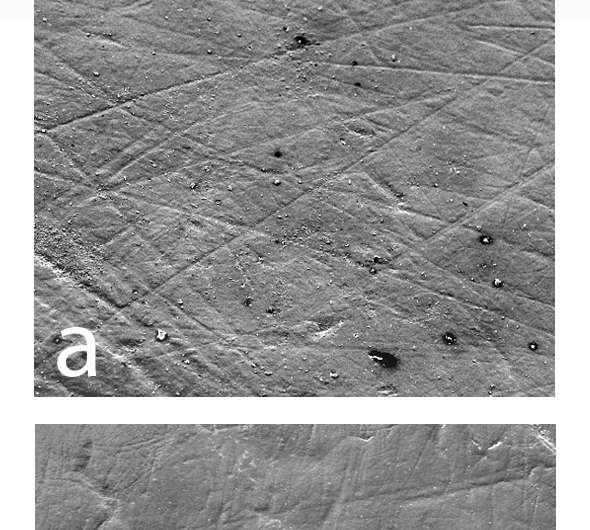Tooth wear patterns suggest Paranthropus early hominins had softer diets than expected

Analysis of wear patterns on fossil teeth from East African hominins suggests the diets of Paranthropus aethiopicus and Paranthropus boisei were softer than had been thought, according to a study published November 16, 2016 in the open-access journal PLOS ONE by Laura Monica Martinez from Universitat de Barcelona, Spain, and colleagues.
Two species in the Paranthropus genus of early hominins, P. aethiopicus and P. boisei, co-existed for some time with early Homo species including H. ergaster, but seem to have had different diets.
Previous isotopic analysis has supported the theory that while H. ergaster, which had relatively small jaws and teeth, consumed a lot of meat, Paranthropus species, which had massive lower jaws and molars with large chewing surfaces, may have specialized to eat a high proportion of fibrous, abrasive C4 plants.
However, examination of wear patterns on the grinding surfaces of hominin teeth has not supported this theory. The authors of the present study aimed to resolve this discrepancy by gathering additional tooth wear data. They examined microscopic scratches on the cheek surfaces of teeth from 167 fossil specimens of Paranthropus and early Homo species from sites in Ethiopia, Kenya and Tanzania.
The researchers found that, contrary to the previous isotopic evidence, the scratch patterns on cheek surfaces of P. aethiopicus and P. boisei teeth suggested that their dietary habits 'did not involve chewing significant amounts of abrasive foods'. However, they note that these species might have eaten less abrasive, brittle C4 plants; which would be consistent with both the isotopic and the dental evidence.
Meanwhile, the scratch patterns found on H. ergaster teeth suggest that they ate more abrasive foods that had been expected, which could indicate that early Homo species also underwent a dietary shift to C4 plants as they evolved. This study provides valuable additional evidence concerning the evolution and composition of the diets of Paranthropus and Homo species over time.
More information: Martínez LM, Estebaranz-Sánchez F, Galbany J, Pérez-Pérez A (2016) Testing Dietary Hypotheses of East African Hominines Using Buccal Dental Microwear Data. PLoS ONE 11(11): e0165447. DOI: 10.1371/journal.pone.0165447
Journal information: PLoS ONE
Provided by Public Library of Science


















